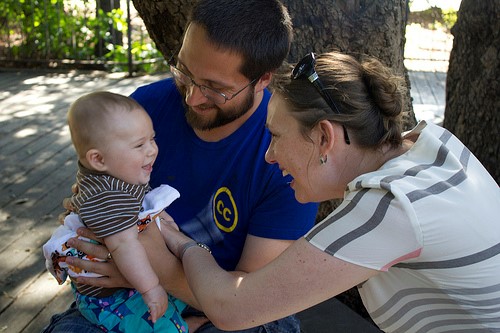Finding out that your child has hearing difficulties sparks a whole range of emotions in parents. Some feel guilty, sad, isolated or angry. Some feel relieved that the issue has been identified, while others are frightened about what the future might hold.
Some 90 per cent of deaf children are born to hearing parents with little or no experience of what it’s like to be deaf. Getting help and support to learn quickly how best to communicate with your child and create a positive environment to help them grow into happy, confident young people is often the first step.
Typically, parents’ biggest anxiety is how they will communicate with their child.
The advice can be overwhelming – signing, lip-reading, speech therapy – so be certain you get clear and balanced information to help you move forward in a way that works for you, your child and the rest of your family.
The family in this video explain how they incorporate all different kinds of language into everyday life.
According to the American Society for Deaf Children, gaining early visual language skills is key for all children and can unlock a whole range of other communication techniques further down the line.
Bricks 4 Kidz program featuring Lego activities at children’s camp #FamilyStrong pic.twitter.com/J7rJQcbKMX
— Amer. Deaf Children (@deafchildren) June 28, 2014
And in the UK, the National Deaf Children’s Society has produced a guide to help parents understand their child’s language development and how facial expressions, eye contact, gentle touch and familiar smells can all play a part in helping to communicate with each other.
Advances in technology can help children get the most out of the hearing world around them.

By quinn.anya
There are around 1,000 different types of digital hearing aids on the market to suit all ages, lifestyle and severity of hearing loss.
Hearing aids amplify sound, but it’s important to get an expert to guide you through the overwhelming array of products available. Specialist consultants will ensure you have all the facts at your fingertips before making a decision. Once your child has an appropriate aid, he or she can access even more technology to break down common communication barriers.
At school, your child’s teacher can use a radio aid that channels her voice directly into the hearing aid blocking out other distracting noises in the room. Similar technology can be used for watching television. A loop system channels the sound directly to your child’s hearing aid enabling the whole family to enjoy their favourite programmes.
Once they are old enough to read, children can access subtitles. Programmes can even be recorded with subtitles and more and more children’s shows are using American Sign Language interpretation.
Computers are a valuable learning tool for all children but they can give those that are deaf a wonderful sense of independence. Top notch software that uses pictures and text to help develop reading and writing skills can minimize adult intervention and help youngsters go it alone.
While technology has its place, there is no substitute for the loving support of the family.
Adapting your parenting skills, home environment and attitude will do wonders for the confidence and independence of your child.


You experience difficulty hearing individuals in an uproarious eatery. Why it happens: As you age — particularly in the event that you’ve been presented to visit uproarious clamors — you may have presbycusis, a sort of steady hearing misfortune brought on by the passing of hair cells in the cochlea, in your inward ear
on March 24, 2017 at 7:33 am Sports Articles